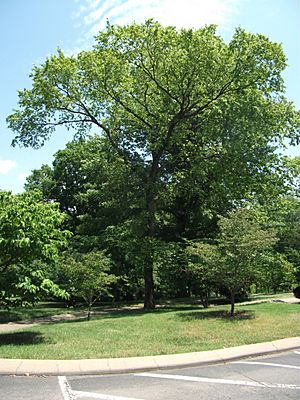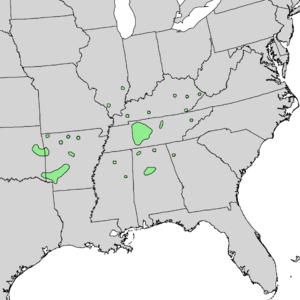Ulmus serotina facts for kids
Quick facts for kids Ulmus serotina |
|
|---|---|
 |
|
| Ulmus serotina, Cheekwood, Nashville, TN | |
| Conservation status | |
| Scientific classification | |
| Genus: |
Ulmus
|
| Species: |
serotina
|
 |
|
| Generalized natural range of Ulmus serotina in the US | |
| Synonyms | |
|
|
The Ulmus serotina, also known as the September elm, is a special tree from North America. It gets its name because its flowers bloom in the autumn, specifically in September. This tree is not very common. You can find it mostly in Tennessee. It also grows in a few other places like Illinois, Kentucky, Arkansas, Mississippi, Oklahoma, Alabama, and Georgia. You can even find some in Nuevo León, Mexico. September elms usually grow on limestone cliffs and near streams, up to about 400 meters high.
Contents
What the September Elm Looks Like
This tree usually doesn't grow taller than 20 meters (about 65 feet). It has a round top with branches that spread out or hang down. When the young branches first grow, they are smooth. As they get older, they develop a corky, rough texture.
The leaves are shaped like an oblong or obovate (wider at the top). They are usually less than 8 centimeters (about 3 inches) long.
Flowers and Seeds
The September elm has special flowers that don't have petals. The wind helps to spread their pollen. These flowers grow in hanging clusters called racemes. They open in September, which helps us tell this tree apart from the cedar elm. Cedar elms are similar but bloom at a different time.
After the flowers, the tree produces seeds called samarae. These seeds are flat, oval-shaped, and about 10–15 millimeters long. They have a deep split at the top. The samarae become ripe in November.
Tree Health: Pests and Diseases
Unfortunately, the September elm can get a serious illness called Dutch elm disease. This disease is very harmful to elm trees.
Growing September Elms
Before Dutch elm disease became a big problem, people sometimes planted September elms for shade in the southern parts of the United States. This tree grows well in most types of soil. However, it doesn't like soil that is too wet (without enough air) or too salty. It can also handle cold weather, down to about -30°C (-23 F).
It's very rare to find September elms growing in Europe. They were briefly sold in the UK many years ago, but not anymore. We don't know if they have ever been grown in Australia or New Zealand. There are no special types (called cultivars) of this tree that are sold.
Big and Famous September Elms
The largest known September elm in the United States is in Davidson County, Tennessee. In 2007, it was measured at 25.5 meters (about 84 feet) tall!
Tree Families: Hybrids
Sometimes, the September elm can mix with other elm trees to create a new kind of tree. One example is called Ulmus × arkansana.
Images for kids






